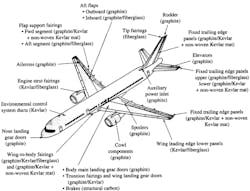While much of the focus on composite aircraft of late has been on the Boeing 787 and its problems with two different types of lithium batteries, a long-standing maintenance concern with composite aircraft has been with minor surface damage not accurately reflecting the extent of damage beneath the surface.
What may appear to be insignificant damage on the surface could mask damage to the layers of material beneath the surface, compromising its strength. This could allow an aircraft with potentially significant damage to be operated.
As more and more composite aircraft enter commercial service, the A-350 will also be a composite aircraft and is expected to enter the fleet in the next year or so, ramp workers need to be aware of the importance of reporting even minor –or what appears to be minor –contact with the aircraft.
What could look like a minor incident with an aluminum-skinned aircraft could be potentially significant in a composite aircraft. Since most ramp employees will not have sufficient expertise in composite aircraft skin and structure maintenance, it is particularly critical that supervisors know that even the most minor damage needs to be reported in accordance with your company’s procedures, usually to either maintenance or the flight crew.
In the past, getting ramp workers to report damage has been difficult, in part because of the pressure to make a schedule and in part because of concerns for disciplinary action. Management needs to find a way to encourage voluntary reporting because of the added stakes when composite aircraft suffer seemingly minor damage.
About the Author

John Goglia
John Goglia has 40+ years experience in the aviation industry. He was the first NTSB member to hold an FAA aircraft mechanic's certificate. He can be reached at [email protected].
John Goglia is an independent aviation safety consultant and Adjunct Professor at Vaughn College of Aeronautics and Technology and regular monthly columnist for four aviation trade publications. He was an airline mechanic for more than 30 years. He has co-authored two text books (Safety Management Systems in Aviation, Ashgate Publishing 2009 and Implementation of Safety Management Systems in Aviation, Ashgate Publishing 2011).
